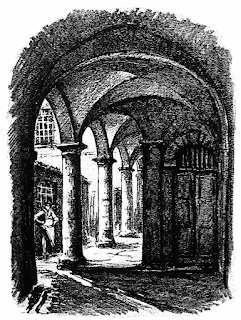Dust and Stars (2021)Since the module has no
cover, here is the next best thing
by Settembrini
Self-published
Levels 9–12
Hello, and welcome to part SIX of **THE RECKONING**, wherein entries of the infamous No Artpunk Contest are taken to task. This promises to be both a treat and a challenge, as the competing entries were written with an intent that is close to my heart: to prove, once and for all, that the power of old-school gaming is found in a fine balance between finely honed and practical design principles, and a strong imagination. That is to say, it is craft before it is art, and this craft can be learned, practiced, and mastered. The following reviews will therefore look not for basic competence – it is assumed that the contest participants would not trip over their own shoelaces or faint at the sight of their own blood – but excellence. The reviews will follow a random order, and they will be shorter than Prince’s original pieces. One adventure, the contest winning Caught in the Web of Past and Present, shall be excluded for two reasons: one, the author plays at my table (and I have previously played in his one-offs); and two, I am going to republish it in an updated edition. With that aside, Deus Vult! Let Destiny prevail!
* * *
As discussed in the review for Tower of the Time Master, tower adventures are hard. The constraints of narrow, vertical spaces – which are by and large also limited by the “realism” of height – do not leave much room for extensive or creative floorplans, so these adventures have to find other things to excel at. While Time Master was outstandingly creative with its interior spaces but playing safe with its room descriptions, Dust and Stars goes the other way in designing a fantastic tower.
This is a high-level AD&D adventure, a very different genre from the OSR’s common “dirt farmer” aesthetic, or the “sweet spot” of mid-level adventuring. This is the point where challenges head into the stratosphere while PC capabilities proliferate unpredictably, leading to unexpected creative solutions. What if the Magic-User enters the dungeon through another plane, or a complex magic puzzle is devastated by an anti-magic field? What if I put the portable hole in the bag of holding? (This is where those DMG edge cases come from.) Conversely, what if the dangers come from unexpected fronts, the puzzles are tough and have no pre-set solution – say, a crucial item is encased within the interior of a stone statue, or a chamber is guarded by ethereal mummies? Creative magic use and reality hacking are to high-level AD&D what ten-foot poles and coils of rope are to its low-level counterpart – it is about being faced with the impossible or improbable, and doing it nevertheless. And of course, you still have to fight your battles on your own terms, or face the consequences. These are the expectations – how does the module stack up?
In Dust and Stars, we visit a tower left behind from a devastating space/time war and shielded from the world by reality-warping magic. An outpost for astronomical research and magical spacefaring, it is an oddity in your standard fantasy world – high-tech by way of super-magic, but certainly sufficiently advanced to be indistinguishable as either to your average dirtfarmer-tier guy. Therefore, the effects of adventuring in this tower are either bound to be revelatory about the nature of the greater world beyond what is “known” (something handled deftly, but with risky consequences in DeepCarbon Observatory), or it is bound to be integrated into a campaign where the characters already know a lot of things going on behind the scenes. This element of the adventure – inscrutable magical technology, bits and pieces of information connecting to a broader context – is handled in a way that the tower can work as a complete mystery, or it can work as a place to find crucial campaign information, or an important item.
There are no navigation- or exploration-related challenges herein, and for all the background, the tower is kind of a monster zoo from a functional perspective – you mostly move from door to door along the tower’s staircases and corridors, defeat the creatures inside (most rooms have some kind of tough monster inside; a few may be negotiated with but most are inimical to mankind), and ponder the clues left behind. This slightly static approach, combined with a gated final area, represents a weakness in the design. The ultimate foes, the star-born sentiserps (high-HD snake guardians) are melee brutes, where the main challenge is how to defeat them without nuking the site. Yet it also has to be said that the combat opportunities are fun, with a variety of opponents requiring different strategies – unleashed elementals, a rakshasha, a bodak with its death gaze, etc. There is something for everyone, including nasty surprises for those proceeding ethereally or unleashing their psionic powers.
Then there is the exploration and investigative part, where the place becomes quite fascinating. Removed from their original context, the artifacts and background elements of the author’s campaign make for a hell of a weird collection of enigmas, a bit like landing on Easter Island and pondering its great stone faces. There are mysteries to untangle and bizarre devices to mess with, fun treasure (a set of slide rules which will fetch a great price, but only from a mathematician, or a set of precision lenses for a telescope, or… particularly valuable erynies panties?!), hints of cosmic going-on, and just a few opportunities to invite great disaster on a planetary scale (“However, the inclined DM may decide that only the continent is destroyed”, he wrote, generously). This is the kind of adventure that would leave character who stay on the surface level non-plussed, while those who enjoy experimentation, non-standard problem-solving, and putting together vague clues would find it memorable. Much depends on whether the GM can convey the tower’s stories to the players – will they see all the complexities, or just weird stuff to breeze through? There is a relationship chart that may enter play – but it is very likely not to. Some sort of play notes on monsters’ communication potential with the players may be good. Then there is a plot-critical steel door that needs a specific key to access... but what if the answer is “LOL, passwall / teleport / disintegrate / dig”? At this level, it is highly likely the party will come in flying through the tower roof, wallhack-style. If they can take it apart this way, a steel door will not stop them.
This contest entry is obviously a snapshot of a larger campaign that had grown rich and complex over years of play, and it is a bit limited by only being what it is. The contest may not be the best introduction to it. The tower is nice as a legendary locale if you are willing to work with it, and you are prepared to accept the premise (specifically, quasi-magical technologies, although not necessarily starfaring). It is a bit like something out of Moorcock’s stories, or Spelljammer but not lame. That’s an accomplishment.
This publication credits two groups of playtesters.
Rating: *** /
*****








